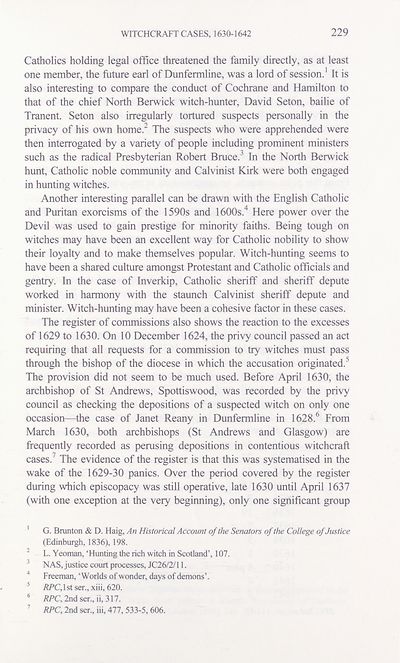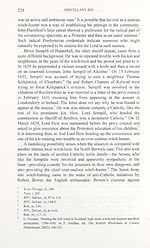Series 5 > Miscellany [of the Scottish History Society] XIII
(244) Page 229
Download files
Complete book:
Individual page:
Thumbnail gallery: Grid view | List view

WITCHCRAFT CASES, 1630-1642
229
Catholics holding legal office threatened the family directly, as at least
one member, the future earl of Dunfermline, was a lord of session.1 It is
also interesting to compare the conduct of Cochrane and Hamilton to
that of the chief North Berwick witch-hunter, David Seton, bailie of
Tranent. Seton also irregularly tortured suspects personally in the
privacy of his own home.2 The suspects who were apprehended were
then interrogated by a variety of people including prominent ministers
such as the radical Presbyterian Robert Bruce.3 In the North Berwick
hunt. Catholic noble community and Calvinist Kirk were both engaged
in hunting witches.
Another interesting parallel can be drawn with the English Catholic
and Puritan exorcisms of the 1590s and 1600s.4 Here power over the
Devil was used to gain prestige for minority faiths. Being tough on
witches may have been an excellent way for Catholic nobility to show
their loyalty and to make themselves popular. Witch-hunting seems to
have been a shared culture amongst Protestant and Catholic officials and
gentry. In the case of Inverkip, Catholic sheriff and sheriff depute
worked in harmony with the staunch Calvinist sheriff depute and
minister. Witch-hunting may have been a cohesive factor in these cases.
The register of commissions also shows the reaction to the excesses
of 1629 to 1630. On 10 December 1624, the privy council passed an act
requiring that all requests for a commission to try witches must pass
through the bishop of the diocese in which the accusation originated.5
The provision did not seem to be much used. Before April 1630, the
archbishop of St Andrews, Spottiswood, was recorded by the privy
council as checking the depositions of a suspected witch on only one
occasion—the case of Janet Reany in Dunfermline in 1628.6 From
March 1630, both archbishops (St Andrews and Glasgow) are
frequently recorded as perusing depositions in contentious witchcraft
cases.7 The evidence of the register is that this was systematised in the
wake of the 1629-30 panics. Over the period covered by the register
during which episcopacy was still operative, late 1630 until April 1637
(with one exception at the very beginning), only one significant group
1 G. Brunton & D. Haig, An Historical Account of the Senators of the College of Justice
(Edinburgh, 1836), 198.
2 L. Yeoman, ‘Hunting the rich witch in Scotland’, 107.
3 NAS, justice court processes, JC26/2/11.
4 Freeman, ‘Worlds of wonder, days of demons’.
5 RPC, 1st ser., xiii, 620.
6 RPC, 2nd ser., ii, 317.
7 RPC, 2nd ser., iii, 477,533-5,606.
229
Catholics holding legal office threatened the family directly, as at least
one member, the future earl of Dunfermline, was a lord of session.1 It is
also interesting to compare the conduct of Cochrane and Hamilton to
that of the chief North Berwick witch-hunter, David Seton, bailie of
Tranent. Seton also irregularly tortured suspects personally in the
privacy of his own home.2 The suspects who were apprehended were
then interrogated by a variety of people including prominent ministers
such as the radical Presbyterian Robert Bruce.3 In the North Berwick
hunt. Catholic noble community and Calvinist Kirk were both engaged
in hunting witches.
Another interesting parallel can be drawn with the English Catholic
and Puritan exorcisms of the 1590s and 1600s.4 Here power over the
Devil was used to gain prestige for minority faiths. Being tough on
witches may have been an excellent way for Catholic nobility to show
their loyalty and to make themselves popular. Witch-hunting seems to
have been a shared culture amongst Protestant and Catholic officials and
gentry. In the case of Inverkip, Catholic sheriff and sheriff depute
worked in harmony with the staunch Calvinist sheriff depute and
minister. Witch-hunting may have been a cohesive factor in these cases.
The register of commissions also shows the reaction to the excesses
of 1629 to 1630. On 10 December 1624, the privy council passed an act
requiring that all requests for a commission to try witches must pass
through the bishop of the diocese in which the accusation originated.5
The provision did not seem to be much used. Before April 1630, the
archbishop of St Andrews, Spottiswood, was recorded by the privy
council as checking the depositions of a suspected witch on only one
occasion—the case of Janet Reany in Dunfermline in 1628.6 From
March 1630, both archbishops (St Andrews and Glasgow) are
frequently recorded as perusing depositions in contentious witchcraft
cases.7 The evidence of the register is that this was systematised in the
wake of the 1629-30 panics. Over the period covered by the register
during which episcopacy was still operative, late 1630 until April 1637
(with one exception at the very beginning), only one significant group
1 G. Brunton & D. Haig, An Historical Account of the Senators of the College of Justice
(Edinburgh, 1836), 198.
2 L. Yeoman, ‘Hunting the rich witch in Scotland’, 107.
3 NAS, justice court processes, JC26/2/11.
4 Freeman, ‘Worlds of wonder, days of demons’.
5 RPC, 1st ser., xiii, 620.
6 RPC, 2nd ser., ii, 317.
7 RPC, 2nd ser., iii, 477,533-5,606.
Set display mode to:
![]() Universal Viewer |
Universal Viewer | ![]() Mirador |
Large image | Transcription
Mirador |
Large image | Transcription
Images and transcriptions on this page, including medium image downloads, may be used under the Creative Commons Attribution 4.0 International Licence unless otherwise stated. ![]()
| Scottish History Society volumes > Series 5 > Miscellany [of the Scottish History Society] XIII > (244) Page 229 |
|---|
| Permanent URL | https://digital.nls.uk/127316457 |
|---|
| Description | Over 180 volumes, published by the Scottish History Society, containing original sources on Scotland's history and people. With a wide range of subjects, the books collectively cover all periods from the 12th to 20th centuries, and reflect changing trends in Scottish history. Sources are accompanied by scholarly interpretation, references and bibliographies. Volumes are usually published annually, and more digitised volumes will be added as they become available. |
|---|


